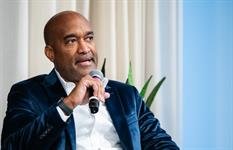From viral TikToks to seafood boil flavor drops and a buzzy new CEO, Red Lobster has become one of the biggest success stories for a brand this season.
In the wake of its late-2024 emergence from bankruptcy, the seafood chain has not only overhauled its leadership and menu but also gained new cultural relevance — both online and offline.
PRsay talked with Lori Cherry, PR director for the Orlando, Fla.-based Red Lobster, to discuss the brand’s media momentum, the importance of authenticity in its comeback and what lies ahead for a restaurant that’s back in the spotlight for all the right reasons.

You’ve worked in several sectors, including for airlines, insurance companies and amusement parks. What was most challenging about helping shepherd a restaurant brand through this kind of turnaround?
I’ve always been in the crisis-communications, reputation-management and challenge communications lanes. I’m able to draw on what I’ve done in the past. The most interesting thing about the restaurant industry, to me, is the level of competition and noise out there.
With the restaurant industry, the general public has hundreds of choices. Cutting through the noise and staying top-of-mind when diners are choosing where to go is a unique challenge for the restaurant industry, and one that I’ve enjoyed, but one that I wasn’t well prepared for in the beginning.
From your perspective, what’s been the most significant factor in how Red Lobster has reemerged after bankruptcy?
The biggest factor has to be the strength of the leadership, bringing in the new CEO, Damola Adamolekun, last September, and then he, in turn, hiring a suite of executives who are industry veterans. We’re very focused on our goals because the strategy has been clearly communicated by the leadership. And when you have a trustworthy captain at the helm of a ship, you feel a lot better when you’re going into unknown waters.

Damola Adamolekun Red Lobster
Was it always the plan to make your new CEO a public face on TikTok and Instagram, or did that happen organically?
In the world of social media, you need the right person at the time. For us, right now, what we need to convey to our guests is that we’re authentic and trustworthy, and we’re making changes that are right for the brand. And he embodies all of that.
It was not part of our plan to make him the face of the brand, or the primary spokesperson. We didn’t come to that decision lightly, because he’s running a company, right? It’s adding a lot to his plate to ask him to also speak on our behalf. But we noticed early on, first in his “Today Show” interview, a few weeks after he started with the company, and then later when he did the “Breakfast Club” podcast in February, that there was an immediate uptick in visitation to the restaurants when he was out there talking about all of the good things that we’re doing at Red Lobster.
Articles on the brand’s resurgence highlight his personal responses on social media. Is he doing any media training to support how he engages with consumers online?
He’s very bright, and he’s well-prepped for every interview, because he has his finger on the pulse of what’s happening internally. So it’s easy to train him for external communications. But he is reading the comments; he is paying attention to what the guests are saying. In his internal communications, in his external communications, his authenticity comes through and it does inspire team members to want to work alongside him.
How does Damola’s energy and leadership style spread from the corporate office to individual restaurants?
It’s fair to say that morale was pretty low before he arrived, and that was no one individual’s fault. But the company — and people — were struggling. So, having a leader who is authentic and not afraid to tell it like it is, he holds regular town hall meetings with the employees here at the corporate headquarters.
We currently have 544 restaurants, all owned by the company. We have a new COO who’s an industry veteran and has built a very strong leadership team. They effectively communicate the message downward, which is evident in things like the new flavor drops we did, because they’re quick. I believe our team members wouldn’t respond so swiftly to requests for change if they weren’t aligned with the message. That alignment starts at the top. Everyone is pulling in the same direction, and that doesn’t happen by accident.
The word I used to first describe Damola is authentic. In his internal and external communications, that authenticity shines through, inspiring team members to want to work alongside him.
Your Seafood Boils story is fascinating. You launched, listened to criticism and dropped new flavors in what seemed like days. Can you explain how that happened so quickly, from the perspective of the communications team?
Damola did an interview on “Good Morning America” [on July 24] and was asked about the new flavor drops. He said this is unheard of, that an organization our size could bring a change and an adjustment to market as quickly as we did. And it speaks to how badly we want to do the right thing for our customers, how passionate our employees are about that. It starts with social listening, and the team monitoring how this new product is being perceived.
And then, once the culinary team stepped in and made the adjustment, the operations team stepped in and made the training adjustments to bring it to restaurants in a week. Communications, to me, a lot of it is media relations. Going back to the reporters who had just covered the unveiling of the crab boils to say we have an update. And then, in terms of social media, being disciplined, on-message, is a very important element of that kind of communication.
Because I had been with the company for several months prior to the arrival of Damola and his executive team, what I saw then was this very slow ship moving along. Within weeks of the new leadership coming on, the pace was picking up tremendously.
This was going to be the same beloved brand, but a very different company in terms of how we interact with our customers and how we respond. And that was going to greatly impact my role. I saw that pretty early on, last fall.
From a communications perspective, what is the biggest challenge in keeping a decades-old hospitality brand fresh and appealing to a new generation, while still retaining loyal customers?
There are two things that I think about this. One involves the “Today Show” interview that Damola did in the fall, right when he started with the company. He was asked for three words that spoke to his vision, or what he wanted the brand to be, and he said: “Relevant, compelling and exciting.”
That has become the thread we have pulled through in everything we’ve done operationally, the changes that we’ve made in the restaurant, red carpet hospitality, how we engage our guests when they come in, culinary and the new menu items we’ve brought out.
But I also, personally, take that “relevant, compelling and exciting” filter and put it on every media opportunity. Because right now, we have a lot of inbound requests for Damola. But on our proactive comms, too, it has to be relevant, compelling and exciting. [Something] could be relevant, a change that we’re making, but it might not be exciting.
The other piece of that, in terms of engaging new customers and younger customers, the next generation of Red Lobster diners, is those culture-jacking moments, and having our listening and having our agencies listen for opportunities for us to step outside of our planned communications and take advantage of what’s trending and what’s relevant, what’s happening in the culture right now.
Not every opportunity is the right opportunity. You have to know when to say “no” and to sit this one out. I have two teenagers, so sometimes I just bounce it off of them, like, “Have you seen this trend on social?”
But that’s what you should expect more of from Red Lobster — that we’re not hiding, we’re not curling up and curling around who we were. We’re trying to lean into the culture and engage the new generation of diners, without alienating our existing base, which has loved us and supported us for a very long time.
Any concerns about Red Lobster fatigue?
You always have that concern. I think that just speaks to strategy. It may look effortless on the outside, and the news is coming in, [but] it’s very strategic. Every opportunity is put through that lens: Is it relevant, compelling, exciting? Is it moving us toward our goal of driving visitation into the restaurants?
At the end of the day, that’s my job — to help us in our recovery by creating fans, by creating diners. So, yeah, I definitely worry about fatigue. But I’m selective as a result.
How does the brand build on this momentum? We’ve seen, this summer, we’re not going to call it Red Lobster summer, but obviously, it’s been…
I’ll call it Red Lobster summer! [Laughs]
How will the brand build on the momentum that we’ve seen this summer?
When Damola came in, he addressed five or six areas of opportunity that the company was going to focus on. Marketing and PR was just one of those. And so, refreshing and updating our restaurants to modernize and make the dining experience more enjoyable is already underway.
We started with doing things like changing the music in the restaurants. We’ve added happy hour. We had limited-time-offer cocktails. And we’ve added partnerships with sports marketing, partnerships with celebrities like Snoop Dog.
So I think what people should expect from us is more great things. The recovery, while we’re almost to the year mark, is in its infancy. There are plans to bring a lot of new and a lot of fresh to our guests. I’m excited. It’s nice to go to work every day and be excited about what comes next.
If you ask me in a couple of months, then I’ll have announcements about what the next big thing is, but for now, just know that we are not resting on our laurels.
I like your lobster-adorned outfit. What do you call it?
“Lobster-Core.” We’re not responsible for it, but we’re very excited to see a lot of lobster love out there in the fashion world this summer. And if we can tap into that, we certainly will.
Here, Cherry talks about the difference it makes for a brand to have a CEO who’s so front and center, embodying the company:
John Elsasser is PRSA’s publications director and host of Strategies & Tactics Live on LinkedIn. He joined PRSA in 1994.
All photos courtesy of Red Lobster.















